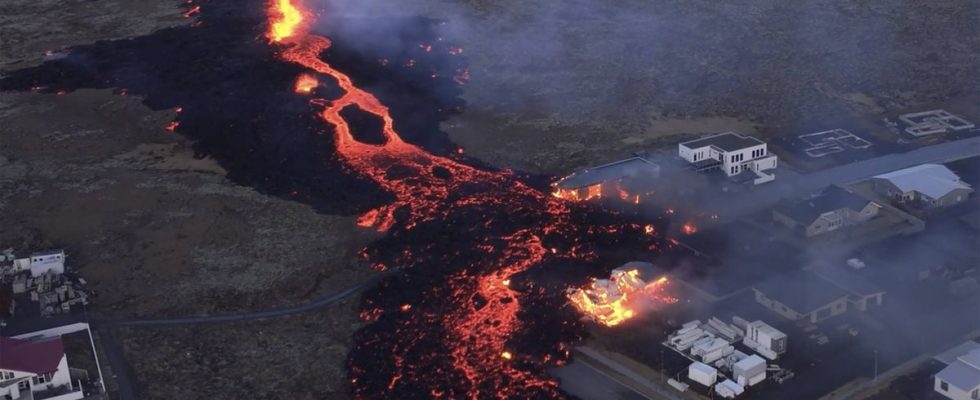The images are necessarily impressive: lava flows engulfing houses in Grindavik in southwest Iceland. The country is fortunately accustomed and prepared for this type of situation and the city’s habitats had been evacuated well before. Crossed by nearly 130 volcanoes, the island has experienced greater volcanic activity since 2021 on the Reykjanes peninsula, southwest of the capital, Reykjavik.
“We are not surprised,” says Fabien Albino, geophysicist and volcanologist at the Institute of Earth Sciences (ISTerre) in Grenoble, who knows Icelandic volcanoes well from studying them regularly. This is a continuation of the eruption at the end of 2023. It is a situation of separation of the American and European plates, which creates an easy path for the magma. In this area, there are effusive eruptions, not very explosive, with lava flows. »
A completely different scenario than that of the explosive eruption of Eyjafjöll in 2010, which projected an immense plume of smoke, paralyzing European airspace. At the time, “this eruption had interacted with the ice of the glacier, which had caused this plume,” explains the researcher. In the case of the port of Grindavik, the vigilance of volcanologists allowed the installation of barriers to keep the main flow of lava away from homes. “We also look at the effect on the inhabitants of the capital [à une quarantaine de kilomètres]with the gases emanating from the eruption,” adds Fabien Albino.
Cycles of eruptions which nevertheless remain unpredictable
An active volcano very close to a large city, this is also what is happening near Naples, in the Phlegraean Fields caldera. “It is a volcano which has not experienced an eruption for a large number of years, but which remains closely monitored, among the most monitored in Europe, because there is a potential for a large volume eruption” , specifies the volcanologist. As he explains, the two situations are not linked and the events in Iceland do not influence those in Italy.
A massive, explosive eruption, however, remains possible. Among Iceland’s nearly 130 volcanoes, Katla, described as even more dangerous than Eyjafjöll, has not erupted since 1918. However, the volcano wakes up approximately twice a century. Volcanologists therefore believe that an eruption is likely in the years to come. “There are cycles, but it’s difficult to predict,” recalls Fabien Albino. On the Grímsvötn [un volcan au centre de l’île] there should have been an eruption in 2022-2023, but cycles can stop or evolve. »
Global warming could encourage eruptions
Grímsvötn is a volcano located under the Icelandic ice cap and the effects of global warming could be an accelerator of a future eruption, according to the volcanologist: “The glacier acts like a cork, if we reduce this pressure, we expect to encourage eruptions a little, to reduce the cycle between eruptions, or to encourage the rise of magma. »
The situation therefore remains closely monitored in Iceland, in particular thanks to seismological monitoring. “The earthquake is a strong sign,” underlines the Grenoble researcher. “The difficulty is knowing whether the seismic crisis leads to an eruption,” says Martine Simoes, research fellow and tectonicist at the Paris Institute of Globe Physics (IPGP). In volcanology, there is the notion ofunrest. » This is the period preceding the eruption, when the volcano shows abnormal signs: jets of vapor, landslides, fumaroles. It can last months, or years, as is the case, for example, in the caldera near Naples, and can also never result in an eruption. To these clues is now added “satellite imagery, which provides additional information,” adds Fabien Albino. The radar image manages to detect the swelling of the volcano. »
In France, Piton de la Fournaise, on Reunion Island, is the most active volcano. Numerous eruptions, sometimes several per year, have been observed there since 2015. “This is our typical case,” notes the volcanologist. Once we have a signal that can show imminent activity, we are in contact with the authorities. » The chance of seeing lava in mainland France is, however, almost zero. If the Puy chain in Auvergne experiences low seismic activity, there is however no sign of volcanic activity.

